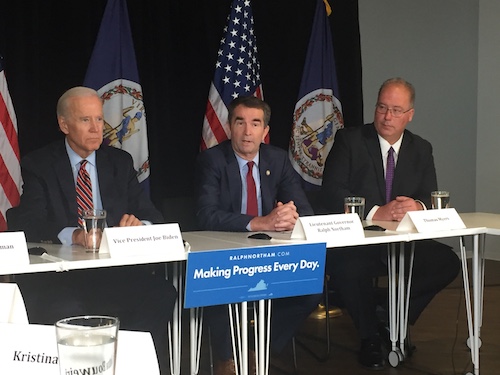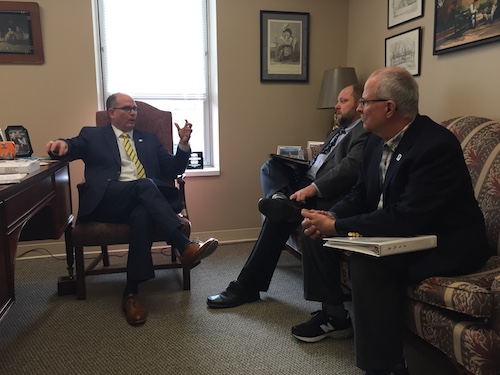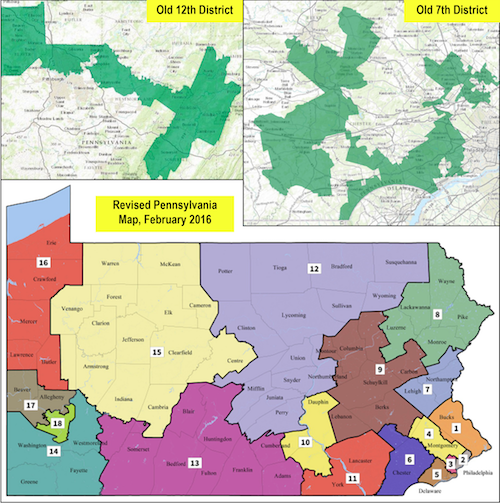“My vote won’t make a difference.”

|
| During the 2017 Virginia governor's race, candidate Ralph Northam is flanked at a campaign event by former Vice President Joe Biden and Tom Myers, right, president of Washington, D.C., Local 26.
|
You hear it every election season. Maybe you’ve even said it yourself.
But after what happened in Virginia’s 2017 election, none of us can ever say it again.
One ballot, a single additional vote for a Newport News, Va., school teacher, would have ended GOP control of the statehouse and opened the door to a worker-friendly legislative agenda.
In fact, one ballot nearly did – until a three-judge panel controversially ruled that its confusing marks showed intent to vote for the Republican. That left the 94th district race between Democrat Shelly Simonds and incumbent David Yancey tied at 11,608 votes apiece.
Ultimately, the race came down to a random drawing, with election officials pulling Yancey’s name out of a bowl, leaving his party in control of the House by a single seat. Had they drawn Simonds’ name, the parties would have shared legislative control with 50 seats each.
“I think we’ll be using this as an example from now until the end of time on how important it is to get and vote,” said Jeff Rowe, business manager at Newport News Local 1340.
“There’s no doubt in my mind that there were one or two people who planned to vote for Shelly and for whatever reason didn’t make it to the polls,” Rowe said. “Their votes would have made a world of difference.”
Even so, a 51-49 split in the House of Delegates represents epic gains in Virginia, where IBEW members were among thousands of volunteers knocking on doors, making phone calls and otherwise helping turn out voters last Nov. 8.
“I think that there was a reawakening since the 2016 election,” said Rowe, who is also president of the Virginia Association of IBEW. “A lot of our members believe it’s time for a change.”
Before the election, Republicans controlled the House by a 66-34 margin, an imbalance that made it all but impossible for pro-worker bills to gain traction. The exhaustive grassroots effort to educate voters and get them to the polls cut the lopsided deficit to a single seat.
“I feel great about that,” Rowe said. “Anybody who knows how the system works knows that you have to get legislation through subcommittees first, and now we’re only a one-person minority. All we have to do is get one other person to agree with us and we can at least get it out of committee. In the past, we’d have to try to get two or three or more people to switch sides.”

|
| Lobbying in Richmond, Va., in late January, Jeff Rowe, center, and Jim Avery of Newport News, Va., Local 1340, discuss workers' issues with state Senator Monty Mason, at desk. Rowe is the local's business manager and also president of IBEW's Virginia State Association.
|
Union legwork in Virginia also helped Democrats hold onto statewide offices, with voters electing Gov. Ralph Northam and Lt. Gov. Justin Fairfax and re-electing Attorney General Mark Herring. Virginia Senate seats will be up for election in 2019.
Northam, who was previously the lieutenant governor, appointed Rowe to his transition team, along with other union representatives. Rowe’s group addressed commerce and trade issues, meeting in Richmond twice in November and December.
“One of the direct, positive benefits of the election was to have a labor voice in those meetings to highlight the need for skilled trades training and put an emphasis on other things that are important to working people,” Rowe said.
While union leaders served on various transition committees, Rowe said he was the only labor representative in his group. “I was the only person talking about this stuff. Had I not been there, it wouldn’t have come up. We didn’t have labor people, for instance, on Bob McDonnell’s transition team,” he said, referring to Virginia’s most recent GOP governor, who served from 2010 to 2014.
Virginia isn’t the only state where unions and workers have had reason to celebrate election results in recent months.
In New Jersey, an army of union volunteers helped pro-worker candidates take back the governor’s office and add to their majorities in the state House and Senate last November. Winning candidates included a dozen IBEW members who were elected and re-elected to state and local offices.
New Jersey is the only state besides Virginia with regular legislative elections in odd-numbered years,
Within hours of being sworn in Jan. 16, Gov. Phil Murphy signed an executive order in support of equal pay for women. His Republican predecessor, Chris Christie, vetoed three equal pay bills during his two terms as governor.
Murphy’s order bars managers in state government from asking job applicants about their previous salaries. He pledged to sign the rule into law and extend it to private businesses if the legislature sends a bill to his desk.
“We don't have to wait to make our economy stronger and fairer, to attack income inequality, and to protect and grow our middle class,” Murphy said in his inaugural address.
Nationwide, worker-friendly candidates have won a string of special elections in places that voted overwhelmingly for Donald Trump in 2016.
One of the most closely watched races was in Alabama, where Trump’s margin of victory was wider than any Republican since Nixon’s in 1972. Barely a year later, in December, former federal prosecutor Doug Jones became the state’s first Democrat in 25 years to win a U.S. Senate seat, narrowly defeating embattled Republican candidate Roy Moore.
In
statehouse races, Democrats have flipped 20 seats since last June. The
latest victories were Feb. 27 in New Hampshire and Connecticut, with
earlier wins in Florida, Georgia, Kentucky, Missouri, New York,
Oklahoma, Washington and Wisconsin.
The Washington race tipped the state Senate to Democrats with a decisive victory by political newcomer Manka Dhingra. The Stand, a state labor news website, was optimistic in January on the eve of hearings about equal pay, safety for workers at the Department of Energy’s Hanford hazardous waste site and other union-backed legislation.

|
| Prior to a Pennsylvania Supreme Court ruling in January, the state's congressional districts had been intricately drawn, or gerrymandered, to heavily favor Republican candidates. At top, the way the 12th and 7th districts appeared before the new map below was approved by the court Feb. 19. The old 7th District was considered the "poster child" for partisan gerrymandering.
|
“The legislative logjam may break loose,” The Stand reported. “Since 2013, Republican control of the state Senate made that chamber Death Valley for many labor-supported bills that repeatedly passed the House but were killed without a Senate vote.”
The next big test for American voters is less than nine months away. All 435 U.S. House seats and 33 of the 100 U.S. Senate seats will be on the ballot Nov. 6, along with 36 governors’ races and the majority of statehouse seats.
Additionally, 32 states have state Supreme Court elections this year, all but three of them in November. Deciding who sits on the bench are some of the most important choices that voters make, as the Pennsylvania Supreme Court demonstrated in January.
The court struck down a grossly partisan map of the state’s congressional districts, ordering a new map be drawn in a matter of weeks, to be in place for May’s primaries. Although Pennsylvania is a swing state with more registered Democrats than Republicans, the gerrymandered map resulted in the GOP holding 13 of the state’s 18 congressional seats.
The court approved a new map Feb. 19, one that erased 1,100 miles of nook-and-cranny boundaries that gave Republicans unfair advantage.
This time around, pro-worker candidates for the U.S. House will have a fighting chance to represent Pennsylvania. But only because voters in 2015 turned out in just enough force to change the court’s balance of power, electing three Democratic justices for a 5-2 majority.
Now, the ripple effect of an election that 73 percent of Pennsylvania voters skipped three years ago – typical of turnout for state and local judicial races -- could swing control of Congress in November.
It’s more evidence that every election and every vote matters. Leading up to Nov. 6, voters across the country can expect to hear the story of how just one more ballot – one – cast for a pro-worker candidate in a Virginia House district could have changed everything.
“We beat that drum constantly – that every vote counts,” IBEW’s Rowe said. “Now we’ve got proof.”